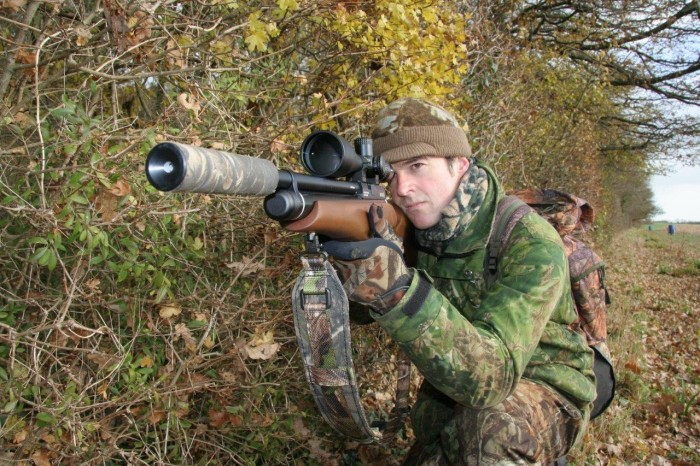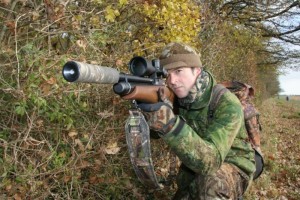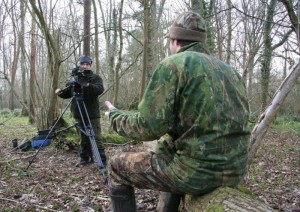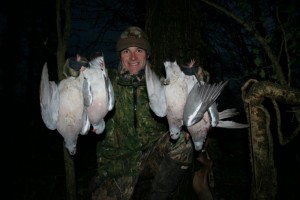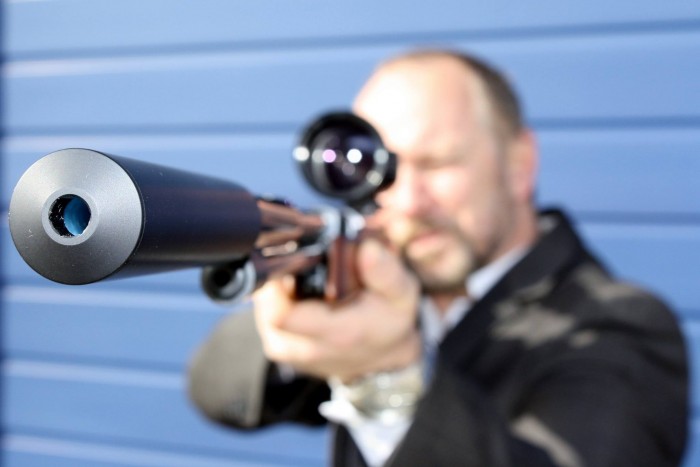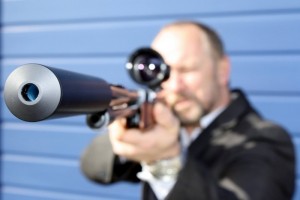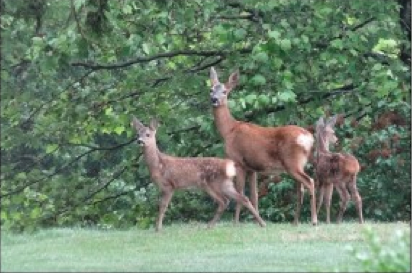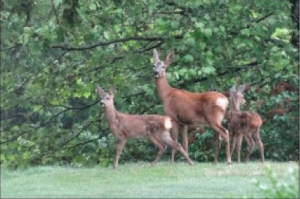With our store selling everything from compound bows to arrow quivers, it seemed only fair that we interview someone from the world of archery, for the avid and passionate fanbase that buy our products.
That’s why our correspondent Hazel Randall talked to archery instructor, Andrew Hood, nine-times winner of the Norfolk Championships (in consecutive years), founder-owner of the successful archery training and advisory business, Feathers and Fletchings, based in Worstead in Norfolk, and proud owner of a banana-yellow Triumph 955 RS.
Andy – tell us about Feathers and Fletchings.
 We do archery-related stuff. We’re archery coaches, mainly. We run sessions for schools and colleges, activity centres, sports centres … that sort of thing. We provide private coaching – that’s the really intense stuff for competitive archers – and we do a lot of these two-and-a-half-day Archery GB Instructor courses. Hopefully that’s a sign of increasing opportunities for youngsters to learn archery.
We do archery-related stuff. We’re archery coaches, mainly. We run sessions for schools and colleges, activity centres, sports centres … that sort of thing. We provide private coaching – that’s the really intense stuff for competitive archers – and we do a lot of these two-and-a-half-day Archery GB Instructor courses. Hopefully that’s a sign of increasing opportunities for youngsters to learn archery.
We’re technical advisors to Hautbois Activity Centre in Coltishall, and a number of other centres across the country. We provide information and guidance regarding industry compliance, teaching practices, personal safety, range position … and we organise their staff training.
Is the arrow wrap product Fletch-o-Set your own design?
Yes – I’m an inventor!
The arrows we usually use for teaching are made of aluminium. Now, there’s a natural oxide layer on the surface of metal that delays corrosion, but to thicken the oxide layer and increase resistance to wear and tear and corrosion, the aluminium is anodised. Are you keeping up?
Just about.
Good. Well, the anodising process leaves the aluminium slightly oily, which makes things very difficult when it comes to sticking on the fletchings. That’s where Fletch-o-Set comes in. It’s a strip of vinyl with an adhesive backing that’s wrapped around the back portion of the arrow shaft, forming a barrier between the oily surface of the metal and the glue that attaches the fletchings.
We can print whatever you like on your Fletch-o-Set strips – a club’s or sponsor’s logo, for example – so it serves a proprietary purpose as well.
Do you teach people with physical disabilities?
Yes, we do. There are ways to accommodate students with disabilities, and this is actually a big part of the GB Instructor training course.
Equal opportunity is key. I’m not talking about equal or uniform treatment. You need to treat people in very different ways if you’re going to provide them with the opportunity to achieve equally. We train instructors to assess the needs of individuals and to provide the help that they need.
I’ll give you some examples: a blind archer may need a tactile sighting aid; an archer with only one arm may need someone to lend a hand in holding the bow or some form of mechanical device to pull and release the string; a wheelchair user may need a little help in manoeuvring the wheelchair.
As an instructor, you have to be aware of different needs and you have to be constantly developing the skills to adapt your lessons to these needs. I’ve worked with severely abused kids. Their perception of right and wrong – i.e. the consequences of ‘doing something wrong’ – is sometimes warped, and can be detrimental to learning. Reassurance and consistent treatment will help to free a child from the bonds of fear. Sounds a bit fluffy, I know, but fear is restrictive. Take social anxiety – a perfect example.
What were you doing before wielding bows and doing archery-related stuff?
Until eighteen years ago, I was an engineer, working in steel fabrication. One particular job I’m very proud of is the design and construction of the enormous steel brazier that contained the first millennium beacon, lit by the Queen.
I know that you care deeply about giving children the opportunities they deserve. Can you tell us about Kids With Cake?
Well, it’s a simple system whereby a proportion of our turnover is siphoned off for the purpose of providing free sessions for disadvantaged kids who wouldn’t otherwise get the opportunity to have a go at archery.
The name comes from an experience I had when teaching after-school archery sessions at a school for ‘difficult’ children. It’s a long story. It’s on the website of one of my other companies. (click here for more).
While we’re talking about kids with cake, I might as well mention the Big Brownie Tea Party in August 2014. I taught an archery session in the garden at 10 Downing Street with 100 brownies – and David Cameron!
Have you ever taught archery abroad?
Yes, a few times. And I’ve also been taught abroad. I had a wonderful experience at the US Olympic Training Centre in California. I was trained by head coach, KiSik Lee, and was awarded Level IV Performance Coach status. I’m not a big-headed person, but I’m really proud of this achievement; there aren’t many coaches outside the US who are trained and qualified to this level.
The laws of physics, as defined by Scottie in Star Trek …
(Andy has an exceptional knowledge of human behaviour and the psychology of learning. He also has an in-depth understanding of the science of archery. He hides his intelligence pretty well, though, behind humour and brusqueness.
When I asked Andy for a business card, he said he couldn’t find any, but he produced, instead, four playing cards – all Kings of Hearts. Then, at point blank range, he performed card tricks that had us all gaping. He told us about his magic tricks.)
Sometimes a group of kids will get restless. You might have children wandering away, others being noisy – and maybe a quiet kid is left out. That’s when I bring out the card tricks. It’s like a magnet. They gather round, totally focussed – and unified in one activity.
(The four playing cards turned out to be business cards!)
You can find out more about Andy and archery training with Feathers And Fledglings at the official site. And we have archery equipment for sale including compound bows and arrow quivers in our ecommerce store.
You can also learn how to shoot a recurve bow in our blog.



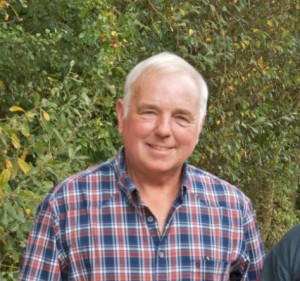 the world – from Spain to Australia, Germany to America, and many at home in Britain. In this interview, he shares with us his illustrious shooting career, his conferencing and shooting venue High Lodge, Clay Pigeon Shooting Association, charity work, and much more.
the world – from Spain to Australia, Germany to America, and many at home in Britain. In this interview, he shares with us his illustrious shooting career, his conferencing and shooting venue High Lodge, Clay Pigeon Shooting Association, charity work, and much more.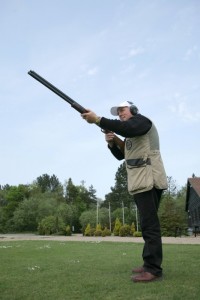 manufactured on site at High Lodge by experienced technicians and engineers. It’s supplied to shooting clubs and competitive events all over the world and is used in conjunction with an automatic counter system.
manufactured on site at High Lodge by experienced technicians and engineers. It’s supplied to shooting clubs and competitive events all over the world and is used in conjunction with an automatic counter system.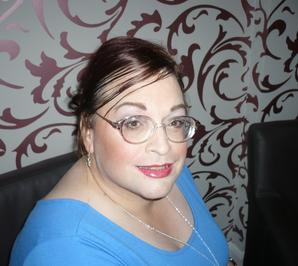
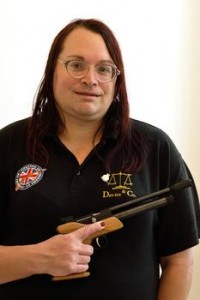
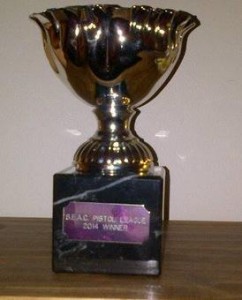 surgery. Another condition is that enough hormonal therapy has been received to ‘minimise gender-related advantages in sport competitions’. Well, it was only twenty years ago that there was considered to be no gender-related advantage in shooting. Very importantly, the final recommendation is that there will be a ‘confidential case-by-case evaluation’.
surgery. Another condition is that enough hormonal therapy has been received to ‘minimise gender-related advantages in sport competitions’. Well, it was only twenty years ago that there was considered to be no gender-related advantage in shooting. Very importantly, the final recommendation is that there will be a ‘confidential case-by-case evaluation’.